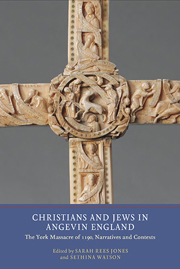Book contents
- Frontmatter
- Contents
- List of Illustrations
- Contributors
- Editor's Preface and Acknowledgments
- Abbreviations
- Introduction: The Moment and Memory of the York Massacre of 1190
- Part I The Events of March 1190
- Part II Jews among Christians in Medieval England
- Part III Representations
- 12 Egyptian Days: From Passion to Exodus in the Representation of Twelfth-Century Jewish-Christian Relations
- 13 ‘De Judaea, muta et surda’: Jewish Conversion in Gerald of Wales's Life of Saint Remigius
- 14 Dehumanizing the Jew at the Funeral of the Virgin Mary in the Thirteenth Century (c. 1170–c. 1350)
- 15 Massacre and Memory: Ethics and Method in Recent Scholarship on Jewish Martyrdom
- 16 The Future of the Jews of York
- Afterword: Violence, Memory and the Traumatic Middle Ages
- Bibliography
- Index
- York Medieval Press: Publications
14 - Dehumanizing the Jew at the Funeral of the Virgin Mary in the Thirteenth Century (c. 1170–c. 1350)
from Part III - Representations
Published online by Cambridge University Press: 05 May 2013
- Frontmatter
- Contents
- List of Illustrations
- Contributors
- Editor's Preface and Acknowledgments
- Abbreviations
- Introduction: The Moment and Memory of the York Massacre of 1190
- Part I The Events of March 1190
- Part II Jews among Christians in Medieval England
- Part III Representations
- 12 Egyptian Days: From Passion to Exodus in the Representation of Twelfth-Century Jewish-Christian Relations
- 13 ‘De Judaea, muta et surda’: Jewish Conversion in Gerald of Wales's Life of Saint Remigius
- 14 Dehumanizing the Jew at the Funeral of the Virgin Mary in the Thirteenth Century (c. 1170–c. 1350)
- 15 Massacre and Memory: Ethics and Method in Recent Scholarship on Jewish Martyrdom
- 16 The Future of the Jews of York
- Afterword: Violence, Memory and the Traumatic Middle Ages
- Bibliography
- Index
- York Medieval Press: Publications
Summary
Before and after the expulsion of the Jews from England in 1290, artists made and audiences understood pictured Jews as embodiments of opposition to the Christian norm, as the quintessential other. Such visual dehumanization of the Jew has been widely considered elsewhere, so this essay will focus on one topos that recurs at York: the Jew in visualizations of the Funeral of the Virgin. Both the textual and visual narratives of this tale depend on the moment when a Jew tries to overturn the platform on which Mary's body is being carried during her burial procession. Upon contact with the pall covering her body, his hand becomes dried, withered and stuck, while his companions in the crowd are struck blind. What makes medieval English images of this event so interesting is the intensity with which artists visually demonize this particular Jew.
Vilification of this figure in English art begins just after the York Massacre in 1190 and escalates long after the expulsion in 1290. Artists developed and articulated a new purely visual character to accommodate the complexities of this narrative, as well as iconographic connections with animals. Audiences read, understood, and accepted this new character in a variety of media. The most compelling examples of the Funeral of the Virgin appear in manuscripts, mostly psalters and books of hours, and stained glass, particularly windows from York Minster. The Funeral can be found in both the marginal space of the ‘bas de page’ as well as the main space of the full page miniature or window light. Instead of presenting a catalogue of each appearance of the Funeral, my focus is on key manuscript illuminations that will contextualize the most visually alarming illustrations of the scene that are found in stained glass from York Minster.
- Type
- Chapter
- Information
- Christians and Jews in Angevin EnglandThe York Massacre of 1190, Narratives and Contexts, pp. 250 - 260Publisher: Boydell & BrewerPrint publication year: 2013

